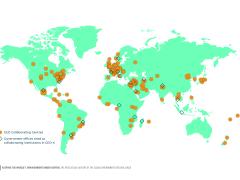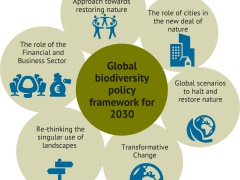Achieving global biodiversity goals makes a big difference for nature and people
By meeting the 2030 targets in the Global Biodiversity Framework (GBF) the world’s forest and other natural land would increase by 3 million km2 (roughly the size of India) by 2050 compared to today. If we continue on current trajectories, on the other hand, the world would lose 3.5 million km2 of nature compared to today.
For the first time, PBL Netherlands Environmental Assessment Agency has quantified what the global implementation of the GBF would deliver for nature. Implementing the GBF alone will get the world a long way toward halting the loss of biodiversity. Combined with effective climate policies to restrict global warming to well below two degrees, it is possible to reverse biodiversity loss and put nature on the path to recovery, PBL concludes in a policy brief presented on the eve of the 16th Conference of the Parties (COP) under the Convention on Biological Diversity (CBD) in Cali, Colombia.
First prospective quantitative assessment
At the previous COP in 2022,196 countries committed to the Convention agreed on four goals for 2050 and 23 targets for 2030 to ‘value, conserve, restore and wisely use biodiversity’. As the world meets for a next round of biodiversity negotiations PBL has made the first prospective quantitative assessment of whether the collective ambition in the 2030 targets is sufficient to achieve the 2050 GBF goals for protection, restoration and sustainable use of nature. This is crucial to know where the world is heading.
Four scenarios exploring biodiversity in 2050
PBL analysed four scenarios: a business-as-usual-scenario, a scenario where GBF targets are implemented (GBF scenario), a scenario where GBF targets and climate pledges (nationally determined contributions; NDCs) are met (GBF+NDC scenario), and a scenario with even more ambitious environmental and intensified conservation policies beyond 2030 (High Environmental Ambition scenario). In the last scenario, global forest and nature would even expand by 5.5 million km2 (almost twice the size of India). Achieving the goals does depend on implementation by individual countries. In this analysis it is assumed that the necessary finance, knowledge, tools, and instruments to realise the GBF will become available.
Restoring nature requires more than conservation policies
A business as usual trajectory will place GBF goals further out of reach and lead to a continuing deterioration of biodiversity. To meet the goals, more is needed than protecting existing ecosystems. To realise improvement in biodiversity the analysis shows that we need to make more space for nature, restore nature, reduce direct pressures on nature such as pollution and climate change, and tackle indirect drivers of biodiversity loss. The latter include changes in production and consumption systems, for example more sustainable food production and dietary changes. Changes in diet would still allow for enough and healthy food for all the world’s population.
Positive climate impact of biodiversity policies
This policy brief shows that climate policy not only contributes to biodiversity conservation but, vice versa, biodiversity policy also helps to limit climate change. Biodiversity policies alone cut 0.2 °C off the 3.1 °C warming in 2100 of the business as usual scenario. This underscores the important role nature plays for climate change mitigation by capturing huge amounts of carbon. For context, if countries meet their NDCs for climate, warming would reach 2.4 °C in 2100. To put nature on the path to recovery as this study shows in the high environmental ambition scenario, climate policies towards well-below two degrees will be necessary.
Importance of mainstreaming biodiversity policies
The four scenarios clearly indicate that conservation policies alone will not be enough to put nature on the path to recovery. Biodiversity loss is driven by many activities in policy areas outside of conservation and climate, such as mining, agriculture and infrastructural works. Therefore biodiversity mainstreaming is an important part of the GBF targets. Ensuring full integration of biodiversity in public decision-making (mainstreaming) will be necessary to address both indirect and direct drivers of biodiversity loss. A coherent approach between biodiversity and climate policies is needed to realize synergies and deal with trade-offs.
Contribution to global biodiversity analysis and review
During COP-16 countries will decide on modalities to strengthen the global review process of the CBD, in order to respond to the gap between global goals and national implementation. As part of this review mechanism it is necessary to regularly assess global progress and to step up efforts if goals are not met. The analysis presented here can serve as input in the global analysis of progress by providing a reference point for evaluation of the global ambitions of countries in their national biodiversity plans and the actual implementation of those plans.




